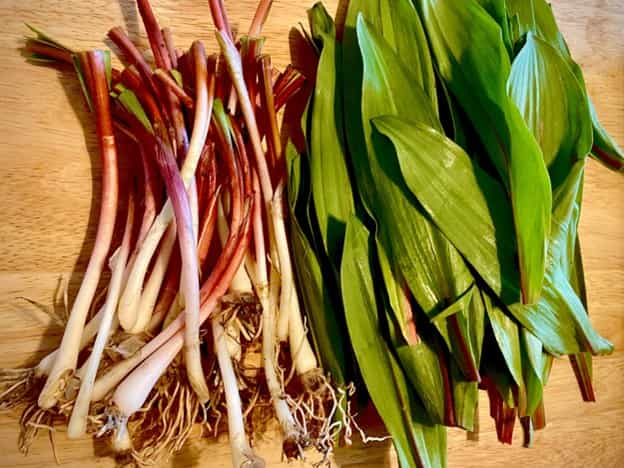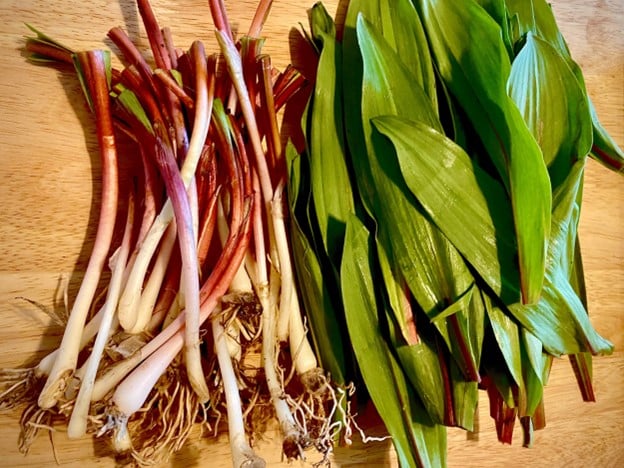It's Ramp Season

As the spring season unfolds across the Midwest, a wave of excitement ripples through the culinary world as we anticipate the arrival of ramps. These wild alliums, sought after for their delicate flavor and culinary versatility, emerge from the forest floor and make their way to local farmers markets for a very brief and exciting period each year. After a trip to the Logan Square Farmer’s Market last week, I came home with half a pound of these delicious vegetables.
 For those of you who may not remember from last year, ramps are a type of wild onion native to North America. They typically grow in wooded areas and are prized for their flavor, which is a combination of garlic and onion with a hint of earthiness. Ramps have broad, smooth leaves that resemble lily of the valley leaves and a small bulb with a white or light purple base. Due to their limited availability and popularity among foragers, ramps have become a symbol of seasonal eating and local food movements.
For those of you who may not remember from last year, ramps are a type of wild onion native to North America. They typically grow in wooded areas and are prized for their flavor, which is a combination of garlic and onion with a hint of earthiness. Ramps have broad, smooth leaves that resemble lily of the valley leaves and a small bulb with a white or light purple base. Due to their limited availability and popularity among foragers, ramps have become a symbol of seasonal eating and local food movements.
During a day dedicated to exploring Korean culinary techniques in the comfort of my home kitchen, I decided to bring the ramps into play in two different recipes, each a great accompaniment to that night’s supper. Adding a Korean-inspired twist, I set out to utilize both parts of the plant.
I divided the ramps into two distinct components: the tender bulbs were made reminiscent of the Korean Myungyi-namul Jangajji through a pickling process in a rich, dark liquid made with soy sauce. Meanwhile, the green ramp leaves became a flavorful sauce creation which I playfully dubbed “Yangpa-Churri”.
Disclaimer: Ramps are foraged wild vegetables and will, more often than not, be full of dirt and sand. When processing ramps, make sure to submerge them entirely in cold water and agitate gently, allowing any debris to sink to the bottom of the washing vessel. Always wash your ramps before using regardless of your source!
Soy Pickled Ramps

And so, again, I turned to the tried-and-tested technique of pickling. While I typically opt for simplicity to ensure versatility, this time I deviated from the norm. I decided to experiment with a denser, more substantial brine, aiming to soften the sharpness of the ramp bulbs. The outcome was an array of flavors that was exciting, to say the least.
Scroll down for a printable version of this recipe
Yields: 1 16-ounce jar
Prep time: 10 minutes
Cook time: 10 minutes
Inactive time: 10 minutes
Total time: 30 minutes
Bulbs and stems from 1/2 lb ramps, roots trimmed and cut into 2-inch lengths
1/2 cup soy sauce
1/2 cup rice wine vinegar (unseasoned)
1/2 cup granulated sugar
1/2 cup water
1/2 teaspoon chili flakes (optional)

2. While the pickling liquid is heating, prepare the ramps by cleaning them thoroughly and cutting them into 2-inch lengths, ensuring to include both the bulbs and stems.
3. Once the pickling liquid reaches a gentle boil, add the optional chili flakes if desired. Then, carefully add the prepared ramp bulbs and stems to a heat-safe container.
 4. Pour the hot pickling liquid over the ramps in the container. Gently press a small amount of plastic wrap over the surface of the liquid to ensure the ramps are submerged.
4. Pour the hot pickling liquid over the ramps in the container. Gently press a small amount of plastic wrap over the surface of the liquid to ensure the ramps are submerged.
These pickled ramps can be used in various ways: chopped into relishes for dressing meats and dumplings, added to sautés and stir-fries for extra flavor, or simply enjoyed on their own as a flavorful snack.
On a side note, don't discard the pickle brine! This liquid, now infused with the delicious ramp flavor, can be used as a seasoning for East Asian soups, broths, sauces, and more. It's a versatile ingredient that adds a burst of rampy goodness to any dish, so be sure to put it to good use!
"Yangpa-Churri"
 Okay, okay…. I made up the name “yangpa-churri.” It doesn’t exist. But while it may not have historical roots, its essence lies in the fusion of classic Argentinian Chimichurri with bold Korean flavors. The ingredients may span different continents but the sauce's purpose remains the same: to provide a vibrant, herbaceous, and acidic accompaniment that elevates meats and vegetables alike.
Okay, okay…. I made up the name “yangpa-churri.” It doesn’t exist. But while it may not have historical roots, its essence lies in the fusion of classic Argentinian Chimichurri with bold Korean flavors. The ingredients may span different continents but the sauce's purpose remains the same: to provide a vibrant, herbaceous, and acidic accompaniment that elevates meats and vegetables alike.
Green leaves of 1/2 lb ramps (about 3 cups packed)
1 red jalapeno or other red chili, finely diced
3 Tablespoons fresh ginger root, finely diced
1/4 cup sesame seeds, toasted
1/4 cup rice wine vinegar
1 1/2 cup grapeseed oil
Salt to taste
 1. In a small saucepot, bring some water to a boil. Prepare a bowl filled with ice and water.
1. In a small saucepot, bring some water to a boil. Prepare a bowl filled with ice and water.
3. In a small bowl, combine the diced jalapeno, ginger, toasted sesame seeds, and rice wine vinegar. Allow the mixture to macerate for at least 5 minutes.
4. In a food processor, add the chopped ramp leaves and begin processing. Gradually drizzle in the grapeseed oil while the food processor is running. Process until the ramp leaves are thoroughly chopped but not pureed.
5. Remove the lid of the food processor and add the remaining ingredients along with the vinegar mixture. Pulse the food processor several times until all ingredients are well dispersed. Season with salt to taste.
This variation of chimichurri is a versatile topping or dipping sauce for grilled meats, fried items like potatoes or lotus root, and makes an excellent dressing for salads.
Store the Yangpa-Churri in an airtight container in the refrigerator. It will keep for about one week, though it may begin to lose its bright green color after three days or so. Feel free to adjust the seasoning and spice level according to your taste preferences.
As we walk through another ramp season, I'm filled with gratitude for the vibrant flavors and culinary inspiration these wild vegetables bring to my kitchen. From tangy pickles to the bold notes of our delicious green sauce, and so many more culinary opportunities, ramps truly elevated any with their unique essence. I am already looking forward to the next season when I go and try to find some out in the wild for myself. Until then, I'll enjoy the bounty of spring produce in our upcoming classes such as:
- Hands-On The Magic of Mushrooms on Saturday, April 20 at 6pm
- Hands-On Tuscany in the Spring on Friday, May 3 at 6pm
- Hands-On Spring Garden Spotlight on Tuesday, May 28 at 6pm

Soy Pickled Ramps
Ingredients
- Bulbs and stems from 1/2 lb ramps, roots trimmed and cut into 2-inch lengths
- 1/2 cup soy sauce
- 1/2 cup rice wine vinegar (unseasoned)
- 1/2 cup granulated sugar
- 1/2 cup water
- 1/2 teaspoon chili flakes (optional)
Instructions
- In a small saucepan, combine the soy sauce, rice wine vinegar, granulated sugar, water, and optional chili flakes. Stir well to dissolve the sugar and bring the mixture to a gentle boil over medium heat.
- While the pickling liquid is heating, prepare the ramps by cleaning them thoroughly and cutting them into 2-inch lengths, ensuring to include both the bulbs and stems.
- Once the pickling liquid reaches a gentle boil, add the optional chili flakes if desired. Then, carefully add the prepared ramp bulbs and stems to a heat-safe container.
- Pour the hot pickling liquid over the ramps in the container. Gently press a small amount of plastic wrap over the surface of the liquid to ensure the ramps are submerged.
- Allow the pickled ramps to cool to room temperature in the liquid. Once cooled, transfer the ramps and their liquid to a clean, airtight container.


